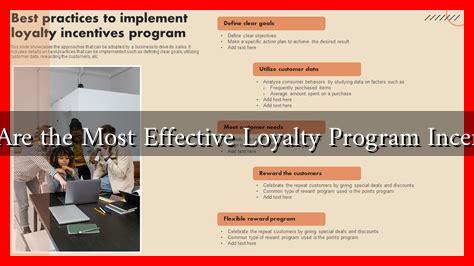-
Table of Contents
What Are the Most Effective Loyalty Program Incentives?
Loyalty programs have become a cornerstone of customer retention strategies across various industries. As businesses strive to cultivate long-term relationships with their customers, understanding the most effective loyalty program incentives is crucial. This article explores the various types of incentives that can enhance customer loyalty, supported by case studies and statistics.
The Importance of Loyalty Programs
Loyalty programs are designed to reward customers for their repeat business, encouraging them to choose one brand over another. According to a study by Bain & Company, increasing customer retention rates by just 5% can lead to an increase in profits of 25% to 95%. This statistic underscores the importance of effective loyalty programs in driving revenue.
Types of Loyalty Program Incentives
There are several types of incentives that businesses can offer to enhance their loyalty programs. Here are some of the most effective:
- Points-Based Rewards: Customers earn points for every purchase, which can be redeemed for discounts, free products, or exclusive offers. For example, Starbucks’ Rewards program allows customers to earn stars for every purchase, which can be redeemed for free drinks and food items.
- Tiers of Membership: Creating different levels of membership can motivate customers to spend more to reach higher tiers. For instance, Sephora’s Beauty Insider program has three tiers—Insider, VIB, and Rouge—each offering increasing benefits such as exclusive access to products and events.
- Cashback Offers: Providing a percentage of the purchase back to the customer can be a strong incentive. For example, credit card companies like Discover offer cashback on purchases, encouraging customers to use their cards more frequently.
- Exclusive Access: Offering members-only access to sales, events, or new products can create a sense of exclusivity. Nike’s membership program provides early access to new releases and special events for its members.
- Referral Bonuses: Encouraging customers to refer friends can expand a brand’s customer base. Dropbox famously grew its user base by offering additional storage space to both the referrer and the referred.
Case Studies of Successful Loyalty Programs
Several companies have successfully implemented loyalty programs that exemplify effective incentives:
- Amazon Prime: Amazon’s subscription service offers a plethora of benefits, including free shipping, exclusive deals, and access to streaming services. The program has over 200 million members worldwide, significantly boosting customer loyalty and repeat purchases.
- Starbucks: The Starbucks Rewards program not only incentivizes purchases through points but also integrates a mobile app that allows for easy ordering and payment. This convenience has led to increased customer engagement and loyalty.
- Walgreens: The myWalgreens program offers personalized deals based on customer shopping habits, along with points for purchases that can be redeemed for discounts. This tailored approach has resulted in a 20% increase in customer engagement.
Statistics Supporting Loyalty Program Effectiveness
Several statistics highlight the effectiveness of loyalty programs:
- According to Fidelity Investments, 77% of consumers participate in loyalty programs.
- A study by Colloquy found that members of loyalty programs generate 12-18% more revenue than non-members.
- Research from A Cloud Guru indicates that 70% of consumers are more likely to recommend a brand with a good loyalty program.
Conclusion
In conclusion, effective loyalty program incentives are essential for fostering customer loyalty and driving business growth. By implementing a mix of points-based rewards, tiered memberships, cashback offers, exclusive access, and referral bonuses, businesses can create compelling loyalty programs that resonate with their customers. The success stories of companies like Amazon, Starbucks, and Walgreens illustrate the potential of well-structured loyalty programs. As consumer preferences continue to evolve, businesses must remain agile and innovative in their approach to loyalty incentives to maintain a competitive edge.

